 | |
|  |
|
|
view titles only (low bandwidth) |
| |
| Sunbathing Selenis, Pluto water, auction$! | Jan 29, 2016 9:09 PM PST | url |
| | |
Added 1 new A* page:Readers sending me a buck or two a month (and sometimes more : o) automatically through the A* Patreon campaign are providing the most help in keeping A* going! And I could use more! ^_^ So check it out if you haven't already (it just got a fancy new format—and you can even see my (almost) smilin' face there : oo); you can even get nifty rewards sent straight from me to you **each and every month**, like e-books, sketches, and even paintings! Here's a sketch I sent to a reader a few months back as their reward for that month of supporting the comic through Patreon:

Thanks everyone for helping keep A* going!!
~~~~~~~~
Using some colorful and creative spectrographic analysis, NASA just found much more water ice on Pluto than anyone had thought was there—a lot of it was hidden from previous studies by methane ice. There are other ices on the surface there too, including nitrogen and carbon monoxide, frozen solid in the frigid temperatures that far away from the Sun!
~~~~~~~~
I mentioned maybe before the holidays that it was coming, and I think next week—Monday, if I can remember : p—I'll start starting the daily eBay auctions for the original watercolor painting behind the day's A* page at a whopping $12.99, up from the current $9.99. Blame inflation in the prices of art supplies! : P But if you shop around I think you'll find it's still a pretty darn good price for a watercolor painting. : ) So anyway the five (or actually six, at least for the next few hours) auctions currently in my eBay listings are your last chance to get one for the old price—cash in while you can! : D
|
·····
|
| |
| Smith's Cloud: action at the outer rim | Jan 28, 2016 8:54 PM PST | url |
| | |
Added 1 new A* page:NASA just posted an article about the Smith Cloud, a cloud of hydrogen just outside the outer edge of our galaxy, but so large—11,000 light years long and 2,500 light years across—that, if it were visible to the eye (the hydrogen is invisible in visible light—it was discovered "in the early 1960s by doctoral astronomy student Gail Smith, who detected the radio waves emitted by its hydrogen"), it would appear 30 times as wide as the full moon in our sky.
NASA says that "hundreds of enormous, high-velocity gas clouds whiz around the outskirts of our galaxy," but for Smith, they've actually been able to calculate its trajectory: currently moving at 700,000 miles per hour, it came out of our galaxy 70 million years ago, and will run back into it in 30 million years, at which point "astronomers believe it will ignite a spectacular burst of star formation, perhaps providing enough gas to make 2 million suns."
For a long time, it was suggested that Smith was a failed dwarf galaxy that had collided with the Milky Way, but new spectrographic measurements taken by Hubble indicate "the Smith Cloud is as rich in sulfur as the Milky Way’s outer disk," which pretty much nixes the failed galaxy theory, and instead suggests that the cloud was a part of our own galaxy that was vigorously ejected—what caused that is still unknown!
|
·····
|
| |
| Black holes, frozen stars, and the universe | Jan 27, 2016 10:18 PM PST | url |
| | |
Added 1 new A* page:Stephen Hawking, the guy who actually did write the book on black holes, is giving two lectures through the BBC's Reith Lectures series, and the BBC has a transcript of the first one (the second is next week), which is all about...black holes! : )
It's a good distillation of our understand of black holes as it has evolved over the past century. One thing I didn't know is that prior to John Wheeler's introduction of the term "black hole" in 1967, they were known as "frozen stars."
And that term is still in use—but for something else! Wikipedia says (this is their Frozen star article in its entirety):
In astronomy, a Frozen star, besides a disused term for a black hole, is a hypothetical type of star that, according to the astronomers Fred Adams and Gregory P. Laughlin, may appear in the future of the Universe when the metallicity of the interstellar medium is several times the solar value.
Characteristics
Due to opacity effects, as metallicity of the interstellar gas increases both the maximum and minimum masses a star can have will decrease. For the latter case, it's expected that an object with a mass of 0.04 solar masses (40 times the mass of Jupiter), that currently would become a brown dwarf unable to fuse hydrogen, could do so ending in the main sequence with a surface temperature of 0 °C (273 K, thus frozen), much cooler than the dimmest red dwarfs of today, and water ice clouds forming in its atmosphere. The luminosity of these objects would be more than a thousand times smaller than the faintest stars currently existing and their lifetimes would be also sensibly longer. |
Adams and Laughlin's research paper the article refers to, A Dying Universe: The Long Term Fate and Evolution of Astrophysical Objects, makes for a pretty interesting read! There's a lot of math—which I mostly can't follow : P—but they still predict a lot of things in fairly straight English; for instance, talking about the eventual fate of the stars in our galaxy (which by this advanced future time, somewhere around 10 septillion (10 with 25 zeroes after it) years after the beginning of the universe (if I got that right...), consist pretty much of half brown dwarfs and half white dwarfs (the vast majority of the mass being in the white dwarfs), with a sprinkling of neutron stars and black holes) and its central supermassive black hole, Sgr A*, they write: "we expect ~ 1 - 10% of the stars to fall to the central black hole and the remainder to be evaporated [into intergalactic space]; the final mass of the central black hole will thus be [1 to 10 billion solar masses.]"
Far beyond the fate of the galaxy, protons themselves will decay; this will lead to white dwarf stars, which last a very very long time, losing their super-dense degenerate matter and plumping up into cold balls of neutral hydrogen of approximately Jupiter size and density. That mass continues to dwindle away until the star is no longer really a star, but merely a 1 meter "rock-like object," which is the ultimate end point of its evolution. : o
After the stars go, even huge black holes that form from the naked supermassive black holes in a very old galactic cluster joining together will eventually evaporate via Hawking radiation, ie quantum particles fizzing away at the edge of their event horizon. So, in the far far far future, " a large fraction of the universe will be in the form of radiation, electrons, positrons, and other decay products."
The paper was written (1996) before more precise measurements led scientists to conclude that the universe appears to be "open"—that is, it will continue to expand forever—so it spends a lot of time exploring scenarios of what would happen if the universe is "closed" (doomed to collapse) or "flat" (static, I guess). It talks about exotic things that would form, like electrons and their antiparticles, positrons, forming into unstable atoms called positronium (any atom of a particle and its antiparticle is an "-onium"), although not much of this would happen in an open universe.
Of the fate of the open universe, they point out that we may simply be in an open "bubble" in a large universe than we can observe, that could itself later reverse and collapse; there is even the possibility that the universe is in a false vacuum state—which is to say that a lower energy state than our current vacuum exists—and could spontaneously switch to the true vacuum state via quantum tunneling, in which case known physical laws could change, or the universe could even in effect be destroyed and remade as something wholly different.
That's getting a little far out, though; far more likely is that it will just keep expanding, and matter and energy as we know it will all end up as "mostly photons of colossal wavelength, neutrinos, electrons, and positrons." I suppose that sounds a little depressing, but they do point out that "the seeming poverty of this distant epoch is perhaps more due to the difficulties inherent in extrapolating far enough into the future, rather than an actual dearth of physical processes."
~~~~~
Speaking of difficulties, I was so out of it today that I forgot to push the "Start Streaming" button before painting today's page—so if you were waiting around for my Twitch stream to come back online, sorry about that, I screwed up and didn't actually record it! >_<
|
·····
|
| |
| Getting all starry eyed : P | Jan 26, 2016 11:52 PM PST | url |
| | | |
Added 1 new A* page:No time to blog, spent too long changing an eye from squinty to starry : P
|
·····
|
| |
| So I customized a stick for Ms. Pac-Man | Jan 25, 2016 11:12 PM PST | url |
| | |
Added 1 new A* page:Here's another post I've been dragging my feet on for a while—but no more! Last spring (well I did say "a while," didn't I? : p), having discovered that there was at last a decent version of Ms. Pac-Man on a game console I owned—in Pac-Man Museum on PS3, specifically—a certain giddiness came upon me, I went a little crazy on the internet, and ended up cobbling together, from various and sundry web sources, a customized arcade stick specifically for playing the supremeness that is Ms. Pac-Man. It ended up looking like this:



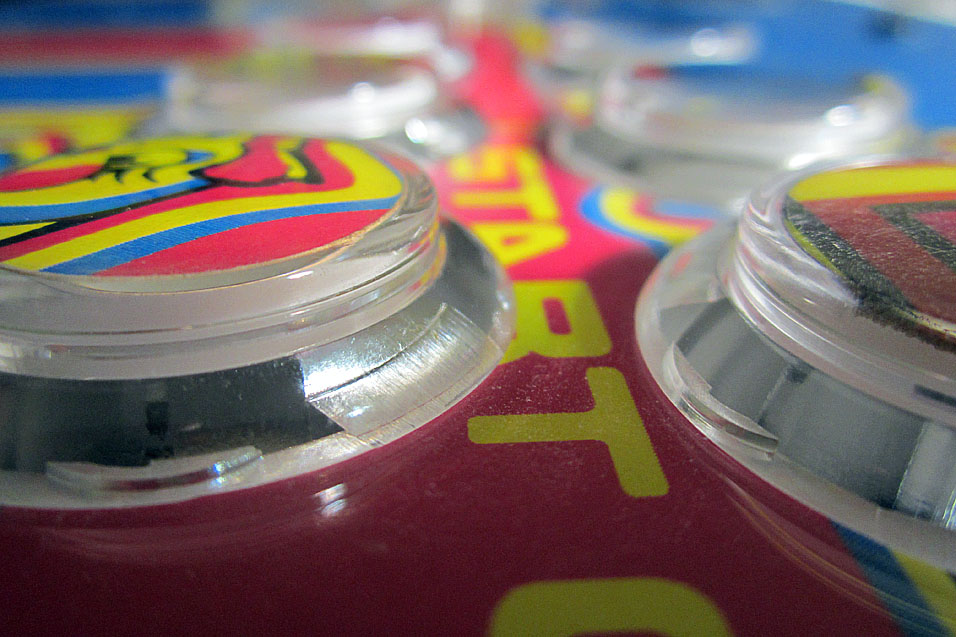
Aside from the looks, I replaced the stick mechanism itself, then the shaft and ball on top of it and the spring and switches inside, trying to make it feel more like the controller on an actual Ms. Pac-Man arcade cabinet than the generic Japanese arcade stick it actually was. Now, generic Japanese arcade sticks are fabulous, but they're clicky and light and precise in a way that is very different from the sort of spongy, smooth, yet restricted movement of the sticks in the old Pac cabs. I did look into getting an actual Pac-Man or Ms. Pac-Man arcade component stick and finding a way to jam it into something that would interface with a PS3, but well the short story is that the old "leaf switch" sticks—and even modern reproductions made by niche companies or hobbyists—are too tall—inside—to fit into the body of the arcade stick controllers made for modern game consoles. So I made do with modifying a modern stick, and I think it turned out pretty well—not quite as smooth and spongy as the old sticks—a little too clacky, since it doesn't have a central rubber grommet like the old leaf switch controllers, to soften the stick as it moves outward—but it has something of them in it.
Feel aside, the actual important thing in a Pac controller is that it absolutely must allow no diagonal input: it must allow only up, down, left, and right to register. Why? Because the old Pac-games worked like this: the Pac character, when coming to an intersection in the maze, would always take, if available, the direction corresponding to the last NEW direction input. This becomes a problem when trying to steer the Pacster with a modern 8-way controller. Consider this common scenario:
1) You're holding the controller's stick in the UP position to move the Pac character in that direction in the maze.
2) While doing this, unbeknownst to you, you inadvertently let the stick drift a little to the right, triggering the RIGHT position simultaneously with the UP position, as is possible in all proper 8-way controllers.
3) Subconsciously correcting, you move the stick back so it is only tripping the UP switch.
==> As long as the tunnel is only heading up, or comes to a branch to the left, Pac will keep heading upward, BUT if your Pac should come to a branch heading right, EVEN THOUGH you are now holding only UP, Paccy will MOVE RIGHT, because while you've been tripping the UP switch on your controller the whole time, the last NEW direction you input was the RIGHT switch you inadvertently tripped in the middle of all that. So the Pac creature can end up moving in a direction you aren't even directing it in, quite possibly resulting in their untimely demise, the loss of your chance to break the world record, and ensuing despair.
Now (this is getting nerdier and nerdier), the industry standard Sanwa JLF arcade stick that comes inside all proper modern console sticks has a rotating "gate" inside it: a sturdy plastic ring around the base of the shaft of the controller, consisting of a round outer section and a square interior section that can, after opening the controller up, be rotated 45 degrees, so that it will now guide the controller's stick into the four orthogonal directions, skipping past the diagonal directions. This is said to convert the 8-way controller into a 4-way controller, but it doesn't, quite: the diagonals will still trip briefly as the stick moves from one orthogonal direction to the next—so you would still get the mis-directed Pac behavior described in the scenario above.
Sanwa's beefier JLW stick also has a rotating gate, and it does much better at avoiding the diagonals, but most of them can STILL engage—only fleetingly, but enough to trip up a Pac mazer. This could probably be solved by very carefully bending the switch contacts inside the stick. But the JLW's switches are also much stiffer than the JLF's, making the stick take more force to engage than a proper Pac-stick should, so I put in softer third-party switches, and with those in place, as an added bonus no diagonals can be triggered at all, making for mechanically error-free Paccing. Huzzah!
I'll spare you the rest of the story, but here's a list of the components for the obsessively curious:
- The stick: Mad Catz Street Fighter IV Tournament Edition Fightstick (PS3) (got a used one on eBay : p)
- The Ms. Pac-Man cabinet artwork: I got the Ms. Pac-Man arcade cabinet vector artwork from here, but the site seems to have disappeared; here's the file
- The stick cover: Mad Catz TE Full / TE-S Panel Covers, Artwork Print and Cut - TE Full Panel, and Acrylic Dust Washer (Tek-Innovations)
- The joystick: Sanwa JLW-TM-8 Joystick (Paradise Arcade Shop)
- The lighter switches: Seimitsu LS-32 / Zippyy(TM) Joystick upgrade Kit (Paradise Arcade Shop)
- A lighter spring: Seimitsu LS-32 Replacement Spring (Focus Attack) (installation video)
- Wiring converter to plug a JLW into a Fightstick .187 to 5-pin Conversion Harness (Focus Attack)
- The clear buttons: Sanwa OBSC-30 White (Paradise Arcade Shop)
- The shaft: Short JLW 10mm Stainless Steel Hollow Joystick Shaft (Paradise Arcade Shop)
- The ball top: Wico Red 38mm tops (Paradise Arcade Shop)
(Pac arcade cabinets had very short sticks, and the short throw of those sticks was essential for quick maneuvering; I was able to find a custom short shaft that actually gives approximately the right length, but the only ball tops it accepts are pretty large, whereas the real Pac arcade sticks had very small ball tops; also, I should note that it took a lot of force to fit the short shaft into the JLW—not quite as precisely machined as it should have been.)
I may also have needed some metric nuts and bolts to mount the JLW inside the Fightstick, maybe something like M4x10mm Screw and Nut (Set of 4) (Focus Attack), but I can't really remember; I know I made a trip to the local hardware store for something like that.
The proper way to do this would be to build your own stick out of wood and the guts of a console control pad and an old actual Pac arcade cabinet stick, but that sort of thing is for the way more technically competent. : o
|
·····
|
| |
| Total Hip Protection | Jan 23, 2016 1:45 AM PST | url |
| | |
Added 1 new A* page:Well I do this webcomic full time which is a little nutty and doesn't make it easy to pay the bills, which is why the A* Patreon campaign is so important, because it gives you, my lovely readers, an easy and automatic way to support my comic-making activities each month so I can keep doing this! Supporters of the comic through Patreon can get themselves rewards sent directly from me each and every month, like this sketch I drew and mailed off to a reader some months back for their support in that month:
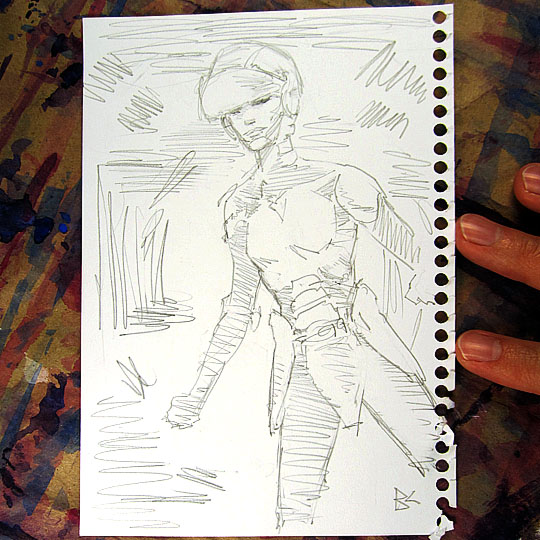
Because slapping huge Gundam-style (? : o) hip shields on every costume design never fails, right? =D >_> Anyway, thank you very much, Patreon campaign supporters—even just a buck or two a month makes a real difference in keeping A* going!
|
·····
|
| |
| Sextuple your productivity watching me paint! | Jan 21, 2016 10:58 PM PST | url |
| | |
Added 1 new A* page:If you're interested to see what painting and drawing an A* page actually looks like, I've been putting 6x time-lapse videos of myself creating the pages on my YouTube channel. My daily work videos have been going up there for a while now—exported from my Twitch channel, where I live-stream them as I work during the day—but it wasn't until about three weeks ago that a viewer suggested speeding them up; so if you don't have hours to sit around watching me make one page, now each hour of work shoots by in just ten minutes! It's kind of eerie to see sketches build themselves up and dissolve over the (now) rapid course of me figuring out a page layout. : o
The latest videos on my YouTube channel are from the previous week, because it takes me three rounds with their editing tools to get them sped up, combined (drawing + painting), and correctly labelled. My Twitch profile stores the videos from the current week, if you missed the live daily broadcasts, but they only trudge along in real time. ; )
|
·····
|
| |
| The episode 27 e-book is here! | Jan 21, 2016 12:42 AM PST | url |
| | | |
Added 1 new A* page:Over the weekend I got the episode 27 e-book added to the episodes & e-books page, where all 101 pages of it are available in high resolution for immediate purchase and download at a price of your choosing. Of course, those wonderful folks supporting the A* Patreon campaign at the e-book reward levels and above will receive a complementary download link for the e-book directly in their inbox at the beginning of next month. : )
|
·····
|
| |
| Crocodile tear | Jan 19, 2016 10:50 PM PST | url |
| | | |
Added 1 new A* page:I didn't really intend for her to be crying here; for some reason I just had the impulse to make the watercolor drip there. ... Impulse control? What's that? : o Anyway yeah, not crying. Oh man this is going to confuse everyone.
|
·····
|
| |
| Cool '60s sci-fi comic: Doc Solar! | Jan 18, 2016 10:22 PM PST | url |
| | |
Added 1 new A* page:Back in October I alluded to having picked up a neat comic book, and here I am finally getting around to writing about it: what I picked up back then, in digital form through Amazon's Comixology app, was Doctor Solar, Man of the Atom Archives Vol. 1, which collects the first seven issues of the monthly comic series from Gold Key Comics that began in October, 1962. I picked it up primarily for the sharp, stylish art by Bob Fujitani, who illustrated the first five issues; issues one and two also had really cool, graphically stylish sci-fi style covers painted by Richard M. Powers. These guys were heavy hitters: Fujitani had been illustrating comics since the early '40s, the "Golden Age" of American comic books, and Powers was one of the most prolific science fiction illustrators of the '50s and early '60s, with "more than 1500 covers and interior illustrations" to his credit (almost exclusively on books: the two covers he painted for Doc Solar constituted half of his total comic work, according to this Archive's introduction by comic writer and historian Mark Evanier), and for that matter, the writer, Paul S. Newman, is "credited in the Guinness Book of World Records as the most prolific comic-book writer, with more than 4,100 published stories totaling approximately 36,000 pages."
And it's actually a pretty fun read: it's a science fiction story—scientist Solar gains the superhuman ability to change into energy after a nuclear accident in his lab—rather than the super-hero type of affair I was expecting—at least until midway through issue 5, when Solar dons a superhero-looking radiation containment suit (he was radioactive after the accident, and worked on in his office only after sealing it with "transparent cadmium-lead film," and wearing a business suit lined with more cadmium lead—and his attractive college chum Gail Sanders, whom he had recently brought onto his nuclear research project as a scientist, would be eternally wondering why he suddenly scorned her advances: he didn't want to expose her to too much of his own radiation—although he couldn't bring himself to tell her about it, a cause of some angst on both sides...mostly hers). Fujitani left the series soon afterwards. But those first four-and-a-half issues are really nifty: Newman had a much clearer idea than, say, Stan Lee, of how science worked, so even though the exact details may not quite add up, his stories are much more grounded and believable than the stuff Marvel Comics was churning out at the time. And (up until he dons the suit in issue 5) Solar solves his problems—many of which are instigated by saboteurs after the fruits of his genius—not with his fists, but with his brain. There should have been way, way more comics like this.
A sample from each of the first four issues—which each contained two Doc Solar stories—in order:
 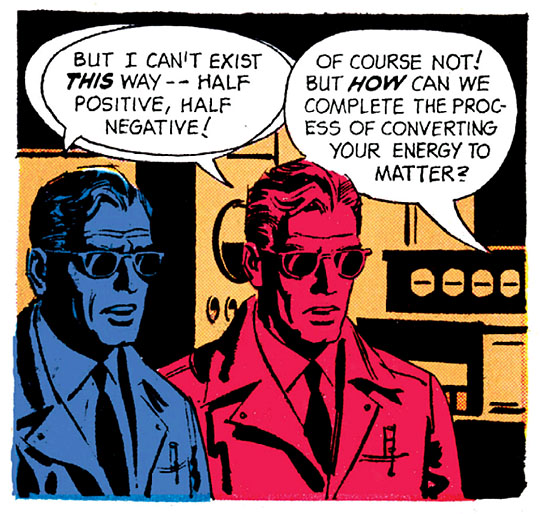 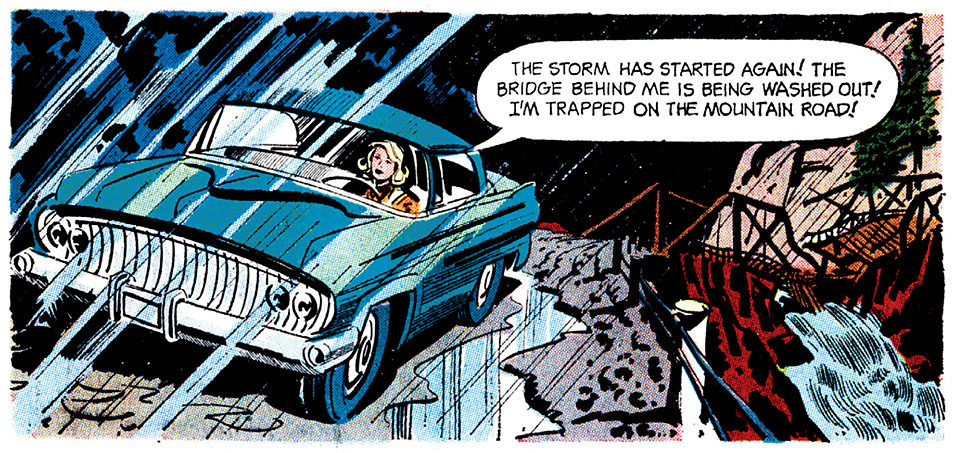 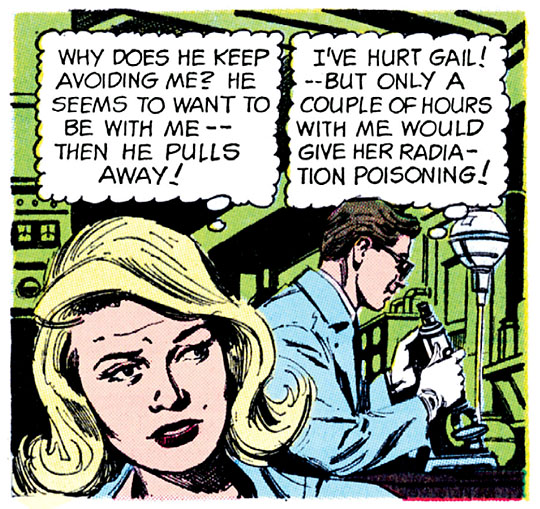
Yeah! Love the bold, flat colors, too, but unfortunately the colorist is uncredited. (Unless it was Fujitani himself? That would have been a little unusual, though.)
|
·····
|
| |
| Magnetar supernova, hi-res Pluto hazes | Jan 16, 2016 3:33 AM PST | url |
| | |
Added 1 new A* page:So it would seem I have a thing for guys in fancy dress doing upbeat, handwaving mission briefings. Let's do it every time, it'll be fun!
~~~~~~~~~~
After yesterday's onslaught of recent space news from this new year, already two more items of interest!
Colossal star explosion detected (BBC) - What may be "the most powerful supernova ever detected" looks to be the cataclysmic death of a huge star, 50-100 times the mass of our own Sun, whose explosion is subsequently being "supercharged" by magnetic energy from the rapidly spinning magnetar created as the central remnant of the supernova explosion; the magnetar would have formed from the part of the huge star that got crushed under almost unimaginable forces as the star collapsed, yet did not rebound explosively outward like most of the rest of the star's mass; instead, the huge forces involved spun the super-dense ball, a mass probably heavier than the Sun but compressed into a diameter of only about 10 miles across—"the density of the interior of a magnetar is such that a thimble full of its substance would have a mass of over 100 million tons"—at something like 1,000 times a second, generating a vast magnetic field in the process. This spin slows as the magnetar's magnetic field interacts with the surrounding material, transferring its energy to that material that is already expanding outward very rapidly from the supernova explosion. The net result, which was first seen in June but is still very energetic, was, at its peak, "200 times more powerful than a typical supernova, making it shine with 570 billion times the brightness of our Sun."
Pluto’s Haze in Bands of Blue (NASA) - They've shown us this in earlier, lower resolution photos from the New Horizons probe, but NASA has just released a highly detailed view of the beautiful blue bands of faint atmosphere visible around Pluto when seen with the Sun behind it, after New Horizons had zipped past the dwarf planet:
Scientists believe the haze is a photochemical smog resulting from the action of sunlight on methane and other molecules in Pluto’s atmosphere, producing a complex mixture of hydrocarbons such as acetylene and ethylene. These hydrocarbons accumulate into small particles, a fraction of a micrometer in size, and scatter sunlight to make the bright blue haze seen in this image.
As they settle down through the atmosphere, the haze particles form numerous intricate, horizontal layers, some extending for hundreds of miles around Pluto. The haze layers extend to altitudes of over 120 miles (200 kilometers). |
|
·····
|
| |
| Space news roundup! A* and more! | Jan 14, 2016 10:57 PM PST | url |
| | |
Added 1 new A* page:Man there's been loads of interesting articles in the past few weeks, I need to do a SPACE NEWS ROUNDUP! (even a bunch of A* / supermassive black hole stuff in there):
Possible Ice Volcano on Pluto Has the ‘Wright Stuff’ (NASA) - one of two possible cryovolcanoes (volcanoes that spew ice instead of magma!) found on Pluto: the 90-mile-wide, 2.5 mile high Wright Mons
Advance in astronomy 'can help find other worlds' (BBC) - the usual method of determining a star's gravity by gauging its average brightness generally only works for close, bright stars, but a new method based on studying variations in the star's brightness may have a much wider application, allowing many more stars to be measured
Black hole caught 'burping' galactic gas supply (BBC) - two huge arcs of gas around the supermassive black hole at the center of galaxy NGC 5195 are found to have been expelled in the black hole's active phase; plus, a binary pair of supermassive black holes, possibly from the merger of a galaxy and a dwarf galaxy, because only one has stars orbiting it—the smaller may actually be a theorized but never yet conclusively detected intermediate-mass black hole
Diamond squeeze hints at metallic hydrogen (BBC) - scientists squish hydrogen molecules between two diamond tips so hard the hydrogen turns solid, then takes on a crystalline structure, possibly close to a long-predicted but never seen "metallic" state, in which the hydrogen can conduct electricity; metallic hydrogen is thought to make up a significant fraction of the intensely pressurized interior of Jupiter (and similar planets), and would explain help account for the planet's very powerful magnetic field
Star clumps harbour 'sweet spot' in search for alien life (BBC) - I try to avoid clickbait "alien life" articles, but this one does talk about the type of environment in a dense star cluster that might be conducive to interplanetary life—like in the dense star regions around the galactic center where A* is set: regions where the stars aren't so densely packed that planetary systems are broken up by gravity from other stars, but are still close enough together for travel from one to the other
Largest ever 'age map' traces galactic history (BBC) - using a formula they developed from known data to estimate the masses of stars in our galaxy based on their color spectra, scientists estimated the ages of 70,000 stars in our galaxy, creating a galactic "age map" illustrating what has already been theorized: the galaxy formed from the inside (now older stars) out (to the more distant, younger stars, like the Sun)
Event horizon snapshot due in 2017 (BBC) - by 2017, a network of radio telescopes hopes to capture a photo of the event horizon of the supermassive black hole at the center of our galaxy: Sagittarius A*! Not only is that super-exciting for us A* fans, it would be the first time any black hole has actually been seen directly. A*'s event horizon is "17 times bigger than the Sun," but it's also "25,000 light years away" (more like 25,900, according to Wikipedia) and shrouded in gas and dust, so getting a photo isn't easy. Actually seeing the black hole would allow scientists to begin to learn how physics behave in such space-warping conditions, and to test how Einstein's theory of general relativity really holds up. In an audio clip in the article, a science team member talks about what our models say an event horizon should actually look like: a crescent, because stuff whips around it so fast that the wavelength of the light from the side on which the stuff is rotating toward us is squished—Doppler shifted—and becomes much brighter than the light from the side that is spinning away, which gets correspondingly stretched and fainter. (Although she doesn't help her case for scientific reliability by not catching that at ~3:25 she mistakenly says A* is "26 million light years" away from us, rather than its actual 26 *thousand* light year distance. : p)
|
·····
|
| |
| Maybe It's Freud Himself This Time! | Jan 13, 2016 11:27 PM PST | url |
| | |
Added 1 new A* page:Okay so after doorways, I seem to be obsessed with drawing nattily dressed little old dudes.
There were two things I did with the watercolor on this page that I haven't done much of before—one kind of accidentally to start with, and the other on purpose. The accidental one was washing off watercolor I'd already put down: the dark blue shadow I put on the side of his face was too dark initially, at the top, then too light as I added water to drag it downward toward where it merged into his shoulder, so before it had dried I started scrubbing the darkest part off the top and washing it down into the lower shadowed areas with a wet brush. And because it's easier to scrub in the middle rather than at the edges, and the scrubbing washes more off the high parts of the paper than the pits, it creates this kind of neat faded look.
The more on-purpose one was painting dry with a dark color over a lighter gradient. I knew I wanted a blue gradient coming down from the top part of the background, around what would be legs in dark pants and shoes, and in watercolor you can always go darker over what you've already painted, so rather than try to paint the gradient around the legs, I just washed and scrubbed some dark blue down the entire background, right through the pencil outlines of the legs, and once that was dry I went back and painted the legs over the blue gradient—this made for a nice clean, seamless division with no dark overlap at the edges, and it also gave a nice subtle cool to warm gradient from the top to the bottom of the legs. So that worked pretty well! I got the idea from Thomas W Schaller's Instagram—in most of his watercolor paintings, he gets a very smooth/sharp effect by painting a dark foreground object over a gradated background.
Also I delineated most of the heaviest shadow along the side of his face at the pencil stage, rather than just winging it all in watercolor like I usually do. I don't do that often, and hm come to think of it, the times I've done it have been mostly more successful when I've been drawing men, like the desert guy in episode 22; I suppose because any extra lines you put down on a woman's face are really risky if you want her to look "pretty"—whereas with an old dude, the more lines, the better! : D Hm I suppose that's part of why I like drawing them, sort of like some artists like drawing giant apes and Godzilla and stuff.
Oh yeah! And another watercolor thing I tried here (old dude / non-Selenis pages are good for experimenting, 'cause who'll miss 'em if it doesn't work out? : o :"D) was using a main shadow color lighter than a main illuminated color: the shadow along the dark side of his head and jacket is lighter than the non-shadowed side of his jacket. I'm not sure quite why, but this type of light/dark inversion can be very effective in creating the right impression. Maybe it's something to do with how our eye adjusts when looking at darker or lighter things around us?
|
·····
|
| |
| Got a date with boxes and tape | Jan 12, 2016 8:29 PM PST | url |
| | | |
Added 1 new A* page:Okay I gotta go get A* art for the last order from the holiday sale that just ended all boxed up and ready to drive down to the post office tomorrow. Thanks everyone who bought my stuff! ^_^
|
·····
|
| |
| Going (back) Up | Jan 11, 2016 11:01 PM PST | url |
| | |
Added 1 new A* page:Oh boy, an elevator ride! >_> This takes me all the way back to episode 12, page 38; I guess I've just been dying to draw another one since then. This one's a lot more "Earth-normal," but hey, it's still an elevator, wheeeeee. I guess it's sort of like my obsession with doors and doorways and entrances (just look, you can hardly get through a page without seeing one), only it also moves up and down, so that's extra cool?
~~~~~~~~
Had a bit of an adventure when my computer's graphic card fizzled out over the weekend, so I didn't quite get to all the A* odds and ends I wanted to then, but now I've got a shiny new one installed (my computer isn't old enough that they don't make compatible cards anymore (it's a PCI Express 2.0 card bus), but it *is* old enough that even the cheapest card I could find is like miles better than my old one ever was—my old one didn't even have an HDMI-out : p and couldn't do 1080p over both of its other video outs at the same time : pp), so we're back in business. : )
|
·····
|
| |
| Supermassive Holiday Sale ends Sunday! | Jan 09, 2016 1:08 AM PST | url |
| | | |
Added 1 new A* page:Last chance to get 50% off of my original A* art: the Supermassive Holiday Sale ends this weekend! Yes, the original paintings and illustrations you can get through this web site—look for the gold "original art" link at the lower left corner of the comic images—are only $25, but only through this Sunday. And then the holidays will officially be over! >_>
|
·····
|
| |
| Gamma rays, galactic clusters, Pluto's "lava" | Jan 07, 2016 10:38 PM PST | url |
| | |
Added 1 new A* page:I made the mistake of looking at Twitter today—a mistake because NASA just tweeted a bunch of really interesting new articles that I now have to take time to tell you about!
- NASA's Fermi Space Telescope Sharpens its High-energy Vision - By reprocessing data from all gamma ray readings taken by the Fermi telescope since 2008, using updated know-how, NASA has been able to put together a much more precise map of the gamma ray sources coming to us from space. It's a pretty cool picture, and they highlight some sources (not A*, though!); there's also a video illustration of how they think most of these gamma rays, coming from supernova remnants, active supermassive black holes in other galaxies, and so forth, are created: a very high-energy electron, moving near light speed, collides with a low-energy photon; this slows the electron slightly, with some of that lost energy transferring to the photon, boosting it into the gamma range.
- NASA's Great Observatories Weigh Massive Young Galaxy Cluster - Using a combination of readings from various powerful telescopes, NASA has determined that a very large galactic cluster, 10 billion light years away—which means the light from it took so long to reach us that we're seeing it when it and the universe were still young—has the mass of about 500 trillion Suns—which is a lot! Studying this early massive structure will help scientists refine their ideas of how the universe has evolved.
- 'X' Marks a Curious Corner on Pluto's Icy Plains - Nifty high-res photos of relatively flat plains on Pluto show that they're actually active! Their surface is broken up into polygonal shapes some 10 to 25 miles across; scientists think these are huge chunks of solid, frozen nitrogen: warmed very slightly beneath the icy surface—miles down, in some cases—by Pluto's faint interior heat, a warmed nitrogen chunk rises, slowly lurching to the surface, where it will eventually cool and sink, a cycle NASA likens to a giant lava lamp.
|
·····
|
| |
| Hey it goes with her hair | Jan 06, 2016 10:41 PM PST | url |
| | | |
Added 1 new A* page:Her outfit was gonna be dark—like a black leather ensemble, you know—but the white was working really well here, so eh well yeah! (Just a coincidence that today I was listening to a podcast interview with Declan Shalvey, the artist—along with colorist Jordie Bellaire—behind that recent super-bright-white-costume Moon Knight reboot for Marvel Comics? : o)
|
·····
|
| |
| Episode 28 begins! | Jan 05, 2016 9:51 PM PST | url |
| | | |
Added 2 new A* pages:And we're off on a new episode!
|
·····
|
| |
| Last week for the Supermassive Holiday Sale! | Jan 04, 2016 10:21 PM PST | url |
| | |
Added 1 new A* page:And that's it for episode 27! Episode 28 starts tomorrow!
~~~~~~
I was so busy last week telling people about the auction of the big new A* painting I made (oh hey there's about an hour and 45 minutes left in the auction as I write this) that the Supermassive Holiday Sale didn't get any attention. So I'm going to extend the Sale for another week, through this coming weekend—it's your last week to get any piece of original art that is for sale through the site here for just $25, which is pretty much 50% off the usual price! That includes the stuff in the episode art galleries, and of course any of the original illustrations or paintings behind the A* pages going back to oh midway through episode 13 or so, which is when I started doing them the old fashioned way rather than on the computer. Even some pages from this climactic scene of episode 27 are left for instant sale price purchase, including these (clicking these thumbnails will take you straight to the store page for that piece):
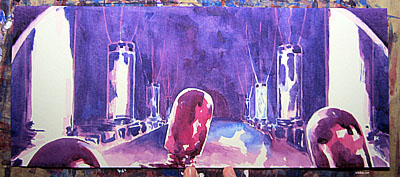 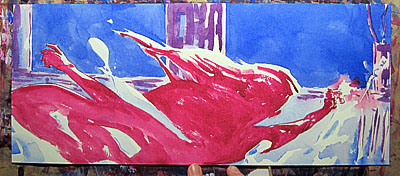 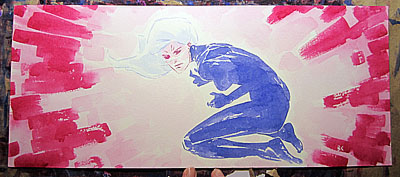
And there are plenty more, just look for the gold "original art" link at the lower left corner of the comic images as you read through the episodes.
|
·····
|
| |
| Big new A* painting is going, going... | Jan 01, 2016 5:12 PM PST | url |
| | |
Added 1 new A* page:Happy 2016! We're starting off with a page #100 : D, AND this is the very last time I can bug you about the big (18" x 24") new A* painting I'm auctioning off, because the auction ends Monday! So check out the auction on eBay soon if you're interested! And thanks everyone who's bid so far. : )) Here's an extra-sized photo of the painting:

Thanks for looking! See you back here next week for the end of episode 27 and the start of episode 28, which will take place in a big new setting in the galactic core!
|
·····
|
|
|
